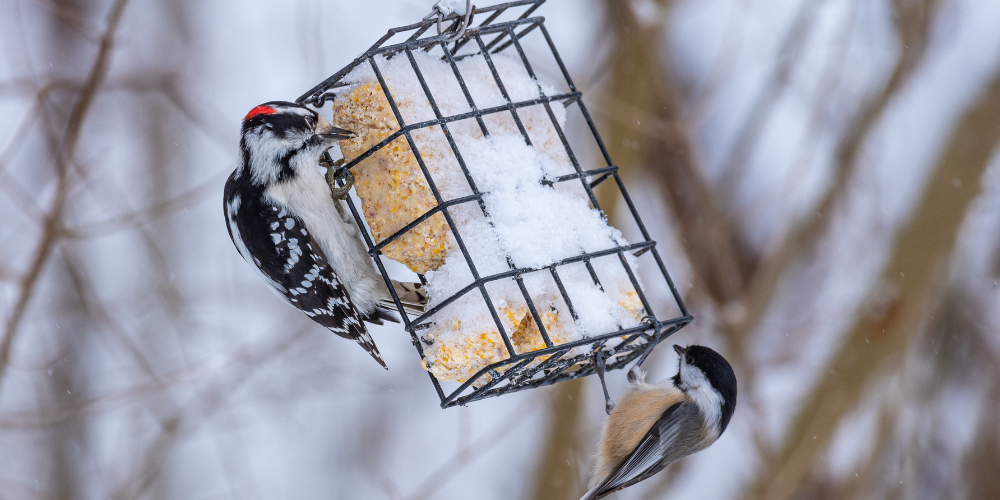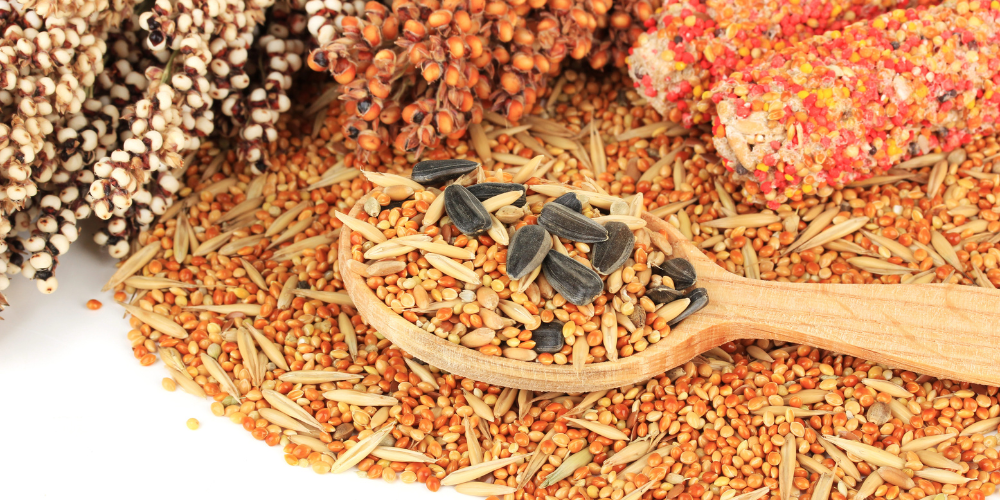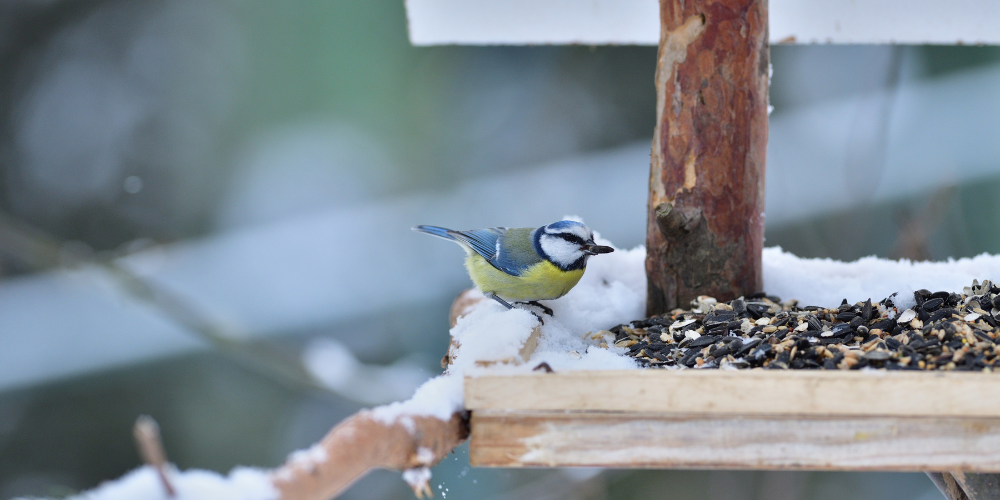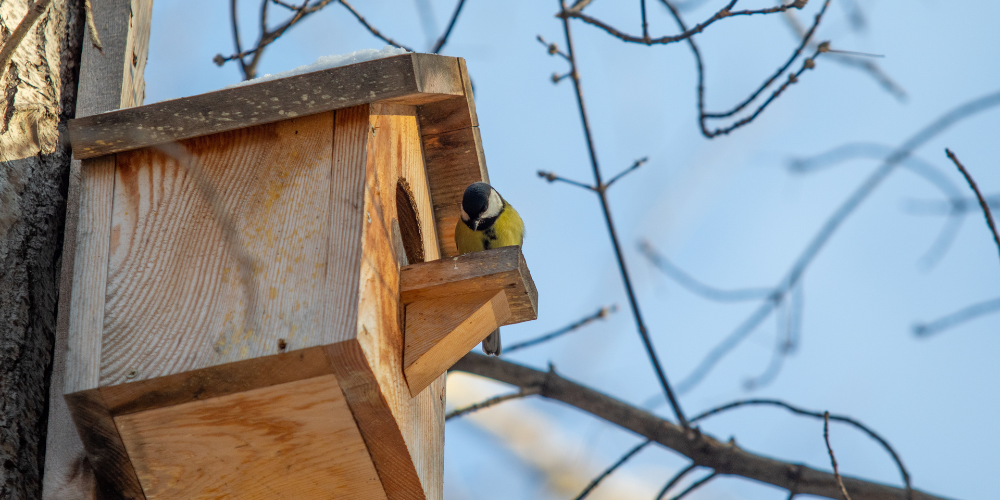Salt Lake City's winters bring about unique challenges for our native feathered friends, as the harsh temperatures and snowy conditions can make it difficult for them to find the resources they need to survive. This means that—as responsible bird-lovers—it's our duty to lend a helping hand during this harsh, unforgiving season. In this guide, we'll explore the best energy-packed bird feeds, discuss essential winter bird feeding dos and don'ts, and answer a few common questions to ensure your backyard becomes a safe haven for a thriving bird community this winter.

Winter Bird Feeding Tips: Fueling Our Feathered Friends
Here are a few of our top tips to help you get started with your winter bird-feeding journey:
Winter Bird Species
While some birds migrate to warmer climates, many species brave the winter cold and choose to remain in Salt Lake City, so research our local species to tailor your winter bird feeding station to their preferences. Common Utahn winter birds include chickadees, finches, sparrows, cardinals, and juncos.
Best Bird Feed for Winter
Choosing the right bird feed is crucial for sustaining birds during the chilly months. Opt for high-energy options like black oil sunflower seeds, millet, and suet. These foods are rich in fats and proteins, providing birds with the nutrients they need to keep warm and energetic all winter.

Types of Seeds for Winter Birds
Different bird species have different seed preferences. Sunflower seeds will attract a wide range of birds, as will mixes containing millet and cracked corn. These seed mixes offer diversity, catering to the tastes of various other winter visitors.
Attracting Birds in Winter
To draw birds to your backyard, consider placing feeders in easily accessible locations. Birds often look for sheltered spots, so position feeders near trees or bushes where they can retreat if needed. Adding water sources, like bird baths, will further entice them, especially when natural sources freeze over.
Feeding Birds in Snow
Snowy conditions shouldn't deter you from your bird-feeding duties. Keep your feeders clear of snow, and consider investing in heated bird baths to provide a liquid water source. Birds need water for drinking and preening, so ensuring it's accessible in winter is crucial!

DIY Bird Feeders for Winter
Get creative with DIY bird feeders to add a personal touch to your bird-friendly space. Pine cone feeders coated in peanut butter and rolled in seeds or simple homemade suet cakes are easy and effective options that also make great, fun-filled family activities!
Do’s and Don'ts of Winter Bird Feeding
Here are a few simple bird feeding do's and don'ts to keep in mind this winter:
Do’s:
Do keep your feeders clean: Regularly clean and disinfect your bird feeders to prevent the spread of diseases.
Do offer a variety of foods: Mix up the menu to attract a diverse array of birds to your backyard.
Do be consistent: Birds rely on a steady, reliable food source, so maintain a consistent feeding schedule.
Don'ts:
Don't use pesticides: Avoid using pesticides near your bird feeders, as they can harm your winged visitors and their food sources.
Don't forget the water: Birds need water year-round, so ensure your backyard features a liquid water source this winter.
Creating a Winter Bird Habitat
Creating a bird-friendly winter habitat in your backyard involves much more than just food and water. Here are a few tips to point you in the right direction:
Bird-Friendly Plants for Winter
Planting native trees and shrubs provides natural food sources for local bird species. Consider varieties that bear fruit in winter, like serviceberries, junipers, and chokeberries, as these offer sustenance when other food is scarce.
Winter Bird Migration
Understanding the significance of winter bird migration is key to appreciating the ebb and flow of bird populations. Many species that pass through Salt Lake City travel great distances in their search for suitable winter habitats, making our efforts crucial to their survival.

Choosing the Right Bird Feeder
Invest in feeders specifically designed for winter use—with features like overhangs to shield food from snow and wind—to avoid waste and help your feathered friends get the most out of their feed. Tube feeders are also excellent for preventing waste and providing a controlled feeding environment.
Suet Feeding in Cold Weather
Suet is a high-energy food that helps birds withstand freezing temperatures, making it a perfect feed option for winter. Just remember to use suet cages or feeders designed to keep the suet from becoming too soft in warmer conditions.
Winter Bird Feeding Safety
Ensure the safety of our feathered guests by keeping your feeders and bird baths clean. Contaminated surfaces can lead to the spread of diseases that can devastate local bird populations.
Contributing to a Winter Bird Habitat
Here are a few other ways you can help birds feel more welcome in Salt Lake City this winter:
Build a Bird Feeding Station
Construct a dedicated bird feeding station with multiple feeders to accommodate various bird species. Elevate your feeders to deter ground predators and ensure they are easily accessible for regular refilling.

Consider Extremely Cold Temperatures
During exceptionally cold periods, increase your feeding frequency to provide birds with the extra energy they'll need to stay warm. It's also a good idea to add some windbreaks around your feeding station to shield your visitors from the biting winter winds.
Engage Your Community
Encourage your neighbors to join the cause by creating bird-friendly environments in their own yards. Establishing a network of winter bird-lovers is a simple way to make a significant impact on local bird populations!
Winter bird feeding is more than just an enjoyable pastime; it's a responsibility we all share that helps our avian friends survive the challenging winter months. By providing the right foods, maintaining a clean environment, and understanding the needs of winter birds, we can create a thriving bird habitat right in our own backyards. So, grab your binoculars, set up your feeders, and pop into Millcreek Gardens to stock up on everything you'll need to make your landscape a bird-friendly paradise year-round!

